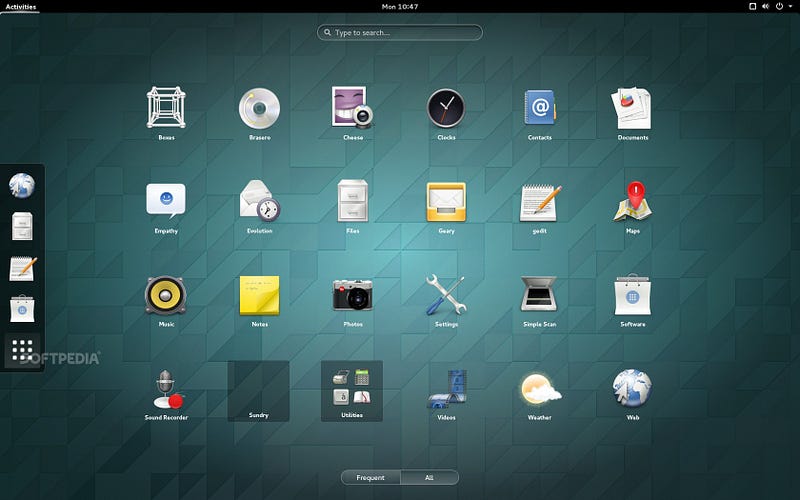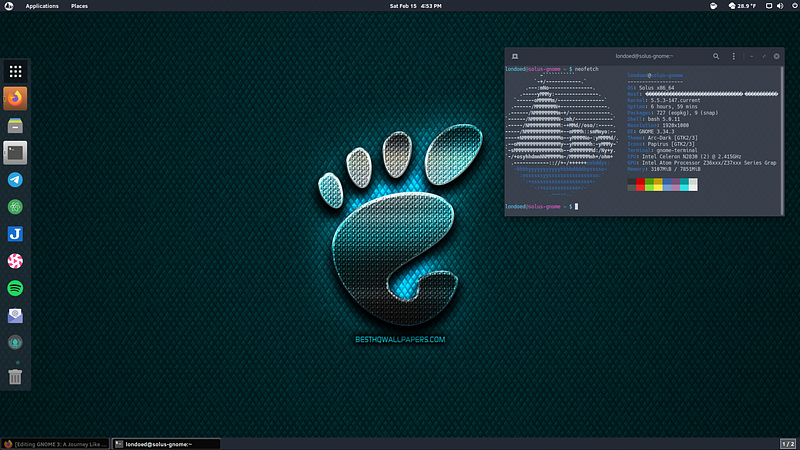There may be no other desktop environment in the Linux world that has had as much controversy surrounding it as the GNOME project. The switch from GNOME 2 to the GNOME 3 Shell in 2011 created a rift in the community unlike any we’ve seen before or after.
This community uproar was born out of the drastic stylistic and workflow changes that GNOME 3 brought with it compared to it’s predecessor. GNOME 2 was set up as a very traditional desktop, with a simple menu system, a top and bottom panel, and was intuitive to anyone who had used other popular GUI operating systems. GNOME 2 gained an incredible amount of exposure due to its integration into Ubuntu, which was shooting up the popularity charts and would soon come to dominate desktop Linux landscape, especially for new users or those that didn’t want to deal with the somewhat painful install process of other distributions. In addition, KDE was having some troubles of their own with the switch from KDE 3 to KDE 4, and many people left for GNOME 2. By 2009, things were really looking up in the GNOME world.

However, when GNOME 3 was released, it changed the whole game. The team behind it decided to move so radically far away from the traditional desktop with no launcher, menus, or icons on the desktop, vertical workspace integrations, and a much more keyboard focused workflow. They created what is known as the GNOME Shell. Even though it may have appeared to be a very lightweight desktop environment from initial viewing, the first iterations were massively clunky and often crashed because of their massive memory usage.
The configurability of GNOME 2 had all but vanished, as many people could no longer find many of the customization options they were accustom to via the now practically non-existent menu system. Instead, a new tool known as GNOME Tweaks was eventually integrated for common changes such as theming and icon packs. They also allowed people to download community created configuration options through the GNOME Extensions website in order to customize their desktop through what has grown into a vast selection of options.

This was so completely opposite of what KDE was doing at the time on the way to their extremely popular Plasma desktop. Instead, KDE was taking the approach of adding customization functionality in a massive array of interconnected menu systems to tweak practically every inch of the desktop imaginable from inside the GUI itself. The fact that tweaking even the most minute pieces of your desktop involved so much work in GNOME 3 really put a damper on those who were massive GNOME 2 fans. Furthermore, there were other consequences than just user fallout from the GNOME 3 transition.
Canonical, the company behind Ubuntu, decided to create their own Unity Shell on top of GNOME instead of using the new GNOME Shell itself, due to differences in opinion between their desktop team and the GNOME team. This was a massive announcement, as many employees at Canonical had been working on the GNOME team for years. In addition, Linux Mint, an up-and-coming Ubuntu derivative, decided to fork GNOME 3 and create their own set of desktop shell extensions, which eventually blossomed into their wonderful Cinnamon desktop environment.

The Solus Project did the same, debuting their Budgie desktop environment in 2013. For the users who preferred GNOME 2’s interface, the MATE desktop environment was born to continue development on the older codebase and improve upon it. All of these forked desktop environments have gone on to find great success, even in distributions not directly related to their creators.
Moreover, Linus Torvalds himself said that he did not care for the GNOME 3 desktop (citing that it was “too complicated” to use) and instead moved to KDE. Debian, one of the most popular open-source projects and Linux distribution in existence (including it’s massive family of offshoots), decided to switch from GNOME 2 to XFCE as their default DE. In short, it was a mess for everyone in the Linux world. However, it is becoming more and more likely that the GNOME team might have just been a bit too early with their radically different concept of a desktop system.
The Resolution
In spite of all that happened, the GNOME team stuck to their guns. They didn’t panic when the criticism was thrown their way (and there was and still is quite a lot of it). No, they somehow had the foresight to realize that what they were building was a completely new way of presenting the desktop and that eventually it would catch on to more and more users. As the years rolled by, the GNOME 3 Shell continued to improve upon itself with each iteration and other DE’s even began implementing GNOME 3-like functionality into their own workflows.
Linus moved back to GNOME in just a year. Debian returned to GNOME 3 as it’s default with the Debian 8 “Jessie” release. Canonical announced it would revert from it’s Unity interface back to GNOME 3 with it’s 18.04 LTS release. Red Hat’s popular Fedora distribution had stuck with GNOME as its DE through it all, popularizing it within the Red Hat community (of whom many also worked on the GNOME project itself).

By 2019, GNOME was arguably back on top, with KDE Plasma being it’s main competitor in the space, just as it had been in the past with GNOME 2 and KDE 3. Now, GNOME is beginning to receive major contributions not only from their massive network of open-source developers, but also from the enterprise Linux companies: Red Hat, Canonical, and SUSE. There seems to be a united momentum behind GNOME today that hasn’t been seen since just before GNOME 2 was discontinued nearly a decade ago.
My Personal Thoughts and Experience
From the lens of an outsider and normal desktop user like myself, I never really thought about it too much at the time. Sure, GNOME 2 is what got me to take desktop Linux seriously via Ubuntu 8.04, but when I truly became Linux-only and got more involved with the technology, Unity already had many of its quirks ironed out. I became extremely productive in it and found no reason to switch to anything else. Sure, I played with other desktop environments and distributions in VMs and on older machines, especially when the community was excited about changes, upgrades, or completely new distributions. However, my daily driver remained Ubuntu for many years.

In 2017, with the announcement that Canonical would drop Unity for GNOME 3, I started looking into other options as I just could not figure out the workflow of the new DE. Sure, some of it was similar to Unity, but there were some stylistic choices that I just couldn’t get over. It was at that time that I began distro-hopping and DE-hopping. I had been using Kubuntu for quite a while on a spare machine, so I naturally moved to Plasma first and loved it (I still do today!). Then came a longer period with Cinnamon, and most recently, I would consider Ubuntu MATE and the MATE desktop environment to be my daily driver (you can read more about my journey through DEs and how I found MATE in a post from earlier this year here).
However, after a recent foray into Intel’s Clear Linux* Project and deciding to try out Solus’s new 4.1 release with GNOME, something has changed regarding my position on the DE. For the first time, it just clicked. I find myself using the tiny Intel NUC with Solus GNOME on it more and more each day. It doesn’t feel buggy, glitchy, or heavy like it once did. The Shell feels more refined and the extensions are much easier to get to for customization. I haven’t experienced a crash and my memory usage levels are pretty close to what I get with Plasma or XFCE with normal computer usage.

The sky is not falling, the world is not ending. I think I might actually like GNOME 3. I might like it a lot more than I ever thought possible. After giving it more of a try, the workflow is beginning to make total sense to me and even feel intuitive. It is very keyboard-driven, which is one thing I loved about Unity, and the shortcuts make sense. It is gorgeous looking and the animations are brilliant. Maybe the loud, small portion of haters in the community were in my head all along? I can’t be quite sure, all I know is that this GNOME (3.34.3 at the time of writing) is vastly superior to what I experienced with Ubuntu 18.04 when it was released (and subsequently with Fedora, Pop_OS, openSUSE, Debian, Manjaro, etc).

However, I have always thought that GNOME gets a lot of unfair flack in the Linux community today due to the past ordeals and the perception that it doesn’t stack up to other competing DEs. I’ll be the first to admit that I was one of the people who didn’t understand or particularly like GNOME 3 and would never suggest it to new users in the past. When Unity was dropped, I left Ubuntu altogether for greener pastures. However, my take on that has changed significantly when I really look back at how it all played out and where GNOME is today as I type this article from within it. With companies like Canonical back in the mix and a seemingly united front for the future, I think that the GNOME desktop will continue to improve and become much more popular in the years to come.
Now, I’m not saying that GNOME is perfect in any way, shape, or form. They still have some massive problems under the hood that need adequate solutions. But, no piece of software is perfect. They are still made by human beings, and human beings have flaws. However, as a whole piece of software, I think that the GNOME Shell today is without a doubt usable, elegant, unique, and just plain fun to work with.

Even if you are a massive GNOME hater, you still have to give the developers behind it their much deserved respect. They have created a massive community of Linux users and consistently attempt to push the envelope, forcing competitors to innovate as well. Competition is one of the greatest things in the open-source world, because it means that software must continue to get better and not only adapt, but innovate to survive. Do you think that Plasma would be as nice as it is today if it wasn’t up against competition from other DEs? Maybe, though probably not. I think it is safe to say that the GNOME project is in good shape today and will continue to survive for many years to come, at least I hope so. I guess we will see what happens when GNOME 4 is released 😉
Thanks for reading and have a wonderful rest of your day!








Be the first to comment at forum.tuxdigital.com